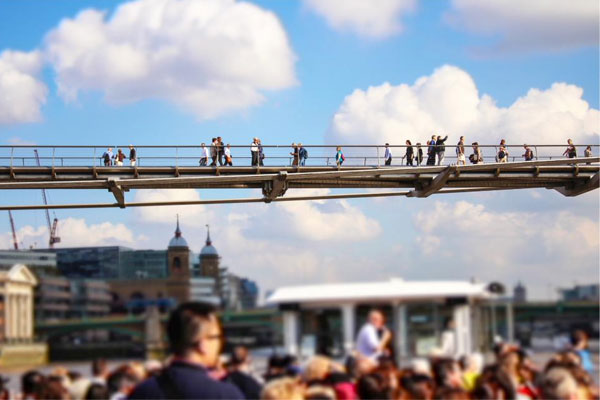How many times have you or your employees dreaded having to go to a meeting? Have you ever not looked forward to sitting at the same conference table or sitting in the same office you have for hundreds of other meetings?
This could become a problem of the past with one of the growing trends in business: walking meetings. This type of meeting is exactly as it sounds. Instead of having a meeting in the usual office setting, the meeting takes place while walking.
Other than a change in location there are many other benefits to getting out of the office and taking a walk.
The Why’s
Improve employee health
By some estimates the average American worker sits for about 9 hours a day. This about 6 hours longer than we should be sitting. Some research has shown that people who sit for more than 6 hours a day are 40 percent more likely to die within the next 15 years than people who sit for less than 3 hours a day.
Walking meetings can keep employees active and help them get some much needed fresh air and sunlight. Walking for just 30 minutes a day can reduce the risk of dementia, certain types of cancers, and heart disease.
Healthier employees are happier employees.
Increase creativity
Research into walking meets shows that they increase creative thinking, up to 60% by some estimates. (Economy, 2015) Creative thinking usually results in more productive meetings. A change in setting can provide inspiration, more flexible thinking, or better problem solving abilities. (Bowles)
In a recent survey of 150 employed adults in the U.S., Clayton, Thomas, & Smothers (2015) found that workers who participate in walking meetings are 5.25% more likely to feel more creative. While 5.25% may not seem like a lot, if the costs of walking meetings are considered, then walking meetings are basically no cost ways to provide increases in creativity.
Break down barriers
Many times walking meetings can change the dynamics of a group, especially the power dynamic between a manager and employees. Without the hierarchy of more traditional meetings, employees and employers can engage on a different level. This may make the meeting more relaxed and more likely to produce better results in less amount of time.
Energize and engage employees
According to one study done by researchers at Johnson & Johnson, after 90 walking meetings employees felt more energized, more focused on their jobs, and more engaged with colleagues and the company.
In the same study by Clayton, Thomas, & Smothers (2015) they found that workers that participate in walking meetings are 8.5% more likely to feel highly engaged.
Encourage communication
Walking meetings have been shown to help people “unplug” from devices that distract their attention. This, in addition to the ability of walking to wake up the brain, enables people to be more honest and open in communication with others.
The How’s
Have a purpose and structure
Because this may be a different style of meeting for employees and managers try to stress that there is still work to be done. The meeting should have an agenda, a purpose, a conclusion, and all the other elements of a regular meeting.
Know your meeting
When planning, make sure the type of meeting is appropriate for walking. Some meetings, like those where supplies are needed or negotiations are taking place, may not be the most appropriate. Brainstorming and decision-making meetings are often the best candidates for walking meetings.
Keep the size in mind
It is important to think about the size of the meeting when planning a walking meeting. These types of meetings are better for one-on-one meetings or meetings of less than 4 people. For larger meetings, standing could be another way of boosting productivity.
Prepare and plan according to the group
The abilities and the needs of the group need to be taken into consideration when planning a walking meeting:
- Ask participants first if they are willing to have a walking meeting.
- The speed of the walk should be okay for everyone and should follow the pace of the slowest person.
- Everyone should be reminded to wear clothing that they feel comfortable walking in.
- Also, make sure the route of the walk is safe and allows all members of the group to make it to the destination and back in the time allotted for the meeting.
Define the destination
When choosing a destination think of a place that employees will enjoy going to and one that will motivate them: a park, an interesting historical or cultural attraction, a monument or sculpture. Try to avoid going to a place where employees will spend money on unnecessary calories or products.
Assign roles
Walking meetings may need a bit more organization since there are more factors involved by being outside. Researchers at the University of California – Riverside found that this can be done by assigning roles to different members of the group.
The Leader – Helps to keep the group focused on the agenda and facilitates the process.
The Guide – Knows the route and gives the group directions along the way, lets people know about possible safety concerns, and provides other routes if necessary.
The Scribe – Takes notes and suggests breaks when important things need to be written down.
Have fun
Maybe this goes without saying, but make sure to still have fun while outside for the walk. Doing work while outside can be a very enjoyable experience. Don’t take it so seriously that employees aren’t willing to try it again.
With a little planning and at basically no additional cost a walking meeting can produce significant gains in many aspects of an organization. Happier employees and happier employers make for a more productive organization. Why not try out a walking meeting to walk and talk your way to success.
Download the eBook and get practical ideas on designing employee engagement activities for your team!
Image via StockSnap under Creative Commons 0.0 license






You really make it seem so easy with your presentation but I find this topic to
be actually something that I think I would never understand.
It seems too complex and extremely broad for me.
I am looking forward for your next post, I will try to get the hang of it!
Every weekend i used to pay a visit this web site, for the reason that i want enjoyment,
since this this site conations truly good funny information too.
Appreciate this post. Will try it out.
Good post but I was wondering if you could write a litte more on this subject?
I’d be very thankful if you could elaborate a little bit further.
Many thanks!
Valuable information. Fortunate me I found your web site unintentionally, and I am stunned why this accident didn’t happened in advance!
I bookmarked it.
Wonderful article! We will be linking to this great
article on our website. Keep up the great writing.
This piece of writing will help the internet visitors for creating new webpage
or even a blog from start to end.
I was recommended this web site through my cousin. I am not sure whether this publish
is written by way of him as no one else understand such distinct approximately my problem.
You are incredible! Thank you!
Thanks for a marvelous posting! I seriously enjoyed reading it,
you might be a great author. I will remember to bookmark your blog and definitely
will come back later on. I want to encourage that you continue your great work, have a nice day!